The Bone Morphogenetic Protein Receptor (BMPR) family includes transmembrane receptors that play vital roles in tissue development and cellular signaling. The BMPR family includes both type I and type II receptors.
Type I receptors consist of BMPR1B (ALK6) and BMPR1A (also called ALK3), while type II receptors comprise BMPR2 and ActRII (Activin receptor type II) subtypes. Such receptors exhibit unique ligand-binding specificities and mediate distinct signaling cascades, even though they could cross-interact with other TGF-β family ligands.
Physiological and pathological significance
BMPR1A and BMPR1B are vital for osteoblast differentiation and chondrogenesis impacting bone remodeling. BMPR signaling contributes to embryonic patterning, migration, cell proliferation, and differentiation in various tissues, such as the central nervous system, lung, heart, and liver.
In several diseases, dysregulation of BMPR signaling has been involved. Mutations in BMPR1A and BMPR2 are linked to hereditary diseases like Pulmonary Arterial Hypertension and Juvenile Polyposis Syndrome, respectively.
Aberrant BMP signaling has been associated with cancers, such as breast, colorectal, and ovarian cancer, where it encourages invasion, tumor growth, and metastasis. Alterations occurring in BMPR expression and activity add up to cardiovascular diseases, fibrotic disorders, and skeletal abnormalities.

BMPR Signaling pathway. Image Credit: doi: 10.1038/nchembio0108-15.
Bench to bedside
Given the BMPR family's considerable involvement in several diseases, targeting these receptors presents a hopeful avenue for therapeutic interventions. Strategies to modulate BMPR signaling consist of the development of small molecule inhibitors, antibodies, and gene therapies.
For example, selective inhibitors of BMPR1A and BMPR1B have displayed potential in inhibiting metastasis and tumor growth in preclinical studies. Besides, gene therapies targeted at restoring BMPR2 function have been examined as a possible treatment for Pulmonary Arterial Hypertension.
Applications in research
BMPR family of proteins is a valuable tool for studying ligand-receptor interactions, downstream signaling events, and determining therapeutic targets. Gorrell et al. utilized a cell-free immunoprecipitation assay to analyze the neutralizing potential of the mouse monoclonal antibody 3F6 to hinder the BMPR2-ECD ligand-binding activity.
Chauvin et al. developed anti‑ALK2 and anti‑ALK3 single‑chain variable fragments (scFvs) from the human scFv phage display library Husc I by using ECD‑Poly‑His (cat#: 10446‑H08H; Sino Biological, Inc.) construct for ALK3.
In another study, Zhang et al. analyzed the impact of RN1 (a natural product extracted from Panax notoginseng) on bone morphogenetic protein receptors (BMPR1A and BMPR2). They reported that RN1 binding can potentially impede the interaction between Gal-3 and the BMPRs.
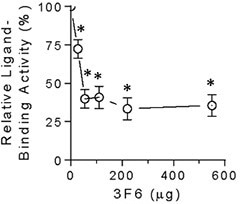
Antibody 3F6 reduces BMPR2-ECD ligand-binding activity in a modified immunoprecipitation assay. Neutralizing the ligand-binding activity of BMPR2-ECD using various amounts of 3F6. Results are quantified by ELISA and expressed as mean ± SEM relative to the ligand-binding activity of BMPR2-ECD in the absence of 3F6. n ≥ 3 per condition. Asterisk indicates p < 0.05 by paired t test. BMPR2-ECD/Fc fusion (Sino Biological, 10551-H03H). Image Credit: R. E. Gorrell et al., BMC Research Notes. doi: 10.1186/s13104-019-4367-0.
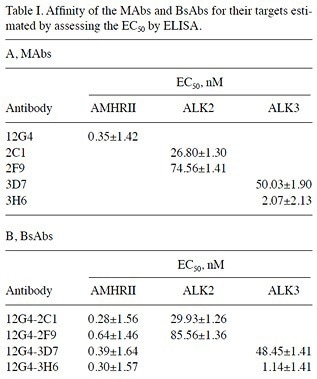
anti‑ALK2 and anti‑ALK3 single‑chain variable fragments (scFvs) were developed from the human scFv phage display library Husc I by using ALK3 ECD‑Poly‑His (Sino Biological, 10446‑H08H). Two scFv antibodies were selected for each target according to their binding affinities. Image Credit: M. Chauvin et al., International Journal of Oncology. doi: 10.3892/ijo.2021.5223.
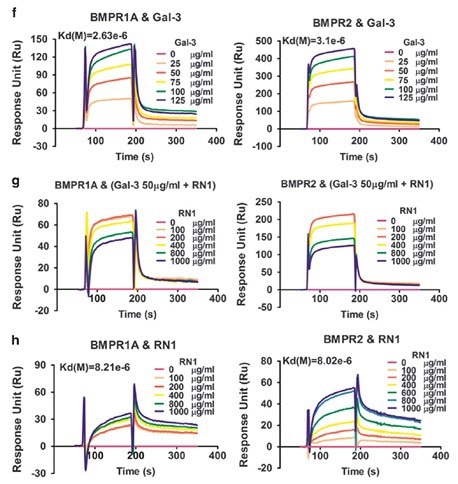
RN1 inhibits Smad/Id-3 signaling pathway by blocking Gal-3 interaction with BMPRs. (f) The interaction was tested by injecting different concentrations of Gal-3 or (g) Gal-3 (50 μg/ml) and different concentrations of RN1 or (h) different concentrations of RN1 in running buffer onto the BMPR1A (left panel) and BMPR2 (right panel) biosensor surface, and the frequency responses were displayed. Recombinant human protein Gal-3, EGFR, BMPR1A, and BMPR2 were obtained from Sino Biological. Image Credit: Zhang, L. et al. Oncogene. doi: 10.1038/onc.2016.306.
Featured recombinant BMPR proteins
Sino Biological has developed a panel of high-activity BMPR proteins from several species to assist in studying the BMPR family.
- High-Purity
- Activity-Validated
- HPLC-Verified
- Cited by scientists
Human BMPR1A protein (His tag). Cat#: 10446-H08H
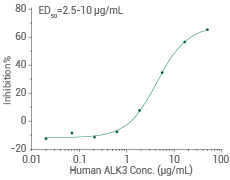
Ability to inhibit BMP4-induced alkaline phosphatase production by MC3T3E1 mouse preosteoblast cells. Image Credit: Sino Biological Inc.
Human BMPRIB protein (hFc tag). Cat#: 10460-H02H

Ability to inhibit rhBMP4-induced alkaline phosphatase production by MC3T3-E1 mouse osteoblastic cells. Image Credit: Sino Biological Inc.
Mouse BMPRIB protein (hFc Tag). Cat#: 50004-M02H
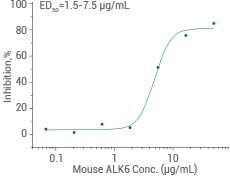
Ability to inhibit BMP4-induced alkaline phosphatase production by MC3T3E1 mouse preosteoblast cells. Image Credit: Sino Biological Inc.
Human BMPR2 protein (His & hFc Tag). Cat#: 10551-H03H
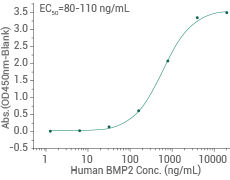
Immobilized human BMPR-II-Fc can bind to biotinylated human BMP2-Fc. Image Credit: Sino Biological Inc.
Human ACVR2A protein (His tag). Cat#: 10257-H08H
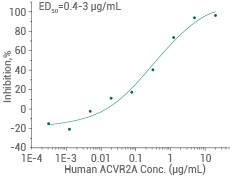
Measured by its ability to neutralize Activin-mediated inhibition on MPC11 cell proliferation. Image Credit: Sino Biological Inc.
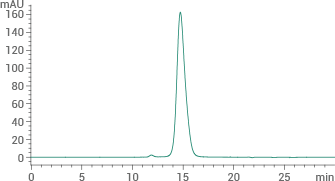
≥ 95 % purity determined by SEC-HPLC. Image Credit: Sino Biological Inc.
More recombinant BMPR proteins
Source: Sino Biological Inc.
| Cat# |
Molecule |
Species |
Expression Host |
Purity |
Activity |
Tag |
| 10446-H02H |
BMPR1A/ALK-3 |
Human |
HEK293 Cells |
> 95% |
Active |
hFc |
50078-M03H
1 Citation |
Mouse |
HEK293 Cells |
> 95% |
Active |
His & hFc |
50078-M08H
1 Citation |
Mouse |
HEK293 Cells |
> 97% |
Active |
His |
| 70051-D02H |
Canine |
HEK293 Cells |
> 97% |
Active |
hFc |
| 10460-H20B |
BMPRIB |
Human |
Baculovirus-Insect Cells |
> 90% |
|
His & GST |
10551-H08H
1 Citation |
BMPR2 |
Human |
HEK293 Cells |
> 95% |
|
His |
| 10257-H02H |
ACVR2A |
Human |
HEK293 Cells |
> 97% |
Active |
hFc |
| 50613-M03H |
Mouse |
HEK293 Cells |
> 97% |
Active |
His & hFc |
| 50613-M08H |
|
HEK293 Cells |
> 97% |
Active |
His |
Featured antibodies for BMPR family
Sino Biological has developed an extensive panel of antibodies against the BMPR family, which could be utilized in IHC-P, ELISA, and WB.
Anti-ACVR2A rabbit pAb. (Cat#: 200225-T40)
Applications: WB, IHC-P
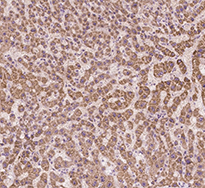
Immunochemical staining of human ACVR2A in human liver with rabbit polyclonal antibody. Image Credit: Sino Biological Inc.
Anti-BMPR1B rabbit pAb. (Cat#: 10460-T48)
Applications: WB, ELISA
U87MG Whole Cell Lysate probed with Anti-ALK6 (149-502) rabbit polyclonal antibody. Image Credit: Sino Biological Inc.
Anti-BMPR1A/ALK-3 rabbit pAb. (Cat#: 100743-T08)
Applications: IHC-P
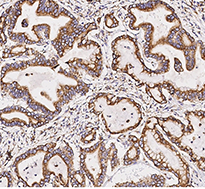
IHC staining of human BMPR1A in human gastric cancer with rabbit polyclonal antibody. Image Credit: Sino Biological Inc.
More antibodies for BMPR family
Source: Sino Biological Inc.
| Cat# |
Antigen |
Species |
Clonality |
Ig Type |
Application |
| 10446-T24 |
BMPR1A/ALK-3 |
Human |
Rabbit PAb |
Rabbit IgG |
ELISA, IHC-P |
50078-R002
1 Citation |
Mouse |
Rabbit MAb |
Rabbit IgG |
ELISA |
50078-RP01
2 Citations |
Mouse |
Rabbit PAb |
Rabbit IgG |
ELISA |
50078-RP02
1 Citation |
Mouse |
Rabbit PAb |
Rabbit IgG |
ELISA, IHC-P |
| 10460-MM06 |
BMPRIB |
Human |
Mouse MAb |
Mouse IgG1 |
ELISA |
10460-RP01
1 Citation |
Human |
Rabbit PAb |
Rabbit IgG |
ELISA |
| 100859-T08 |
Human |
Rabbit PAb |
Rabbit IgG |
IHC-P |
10551-RP01
1 Citation |
BMPR2 |
Human |
Rabbit PAb |
Rabbit IgG |
ELISA |
| 10551-RP02 |
Human |
Rabbit PAb |
Rabbit IgG |
ELISA |
| 10551-T16 |
Human |
Rabbit PAb |
Rabbit IgG |
ELISA |
10257-T16
1 Citation |
ACVR2A |
Human |
Rabbit PAb |
Rabbit IgG |
ELISA |
| 10257-T48 |
Human |
Rabbit PAb |
Rabbit IgG |
WB, ELISA |